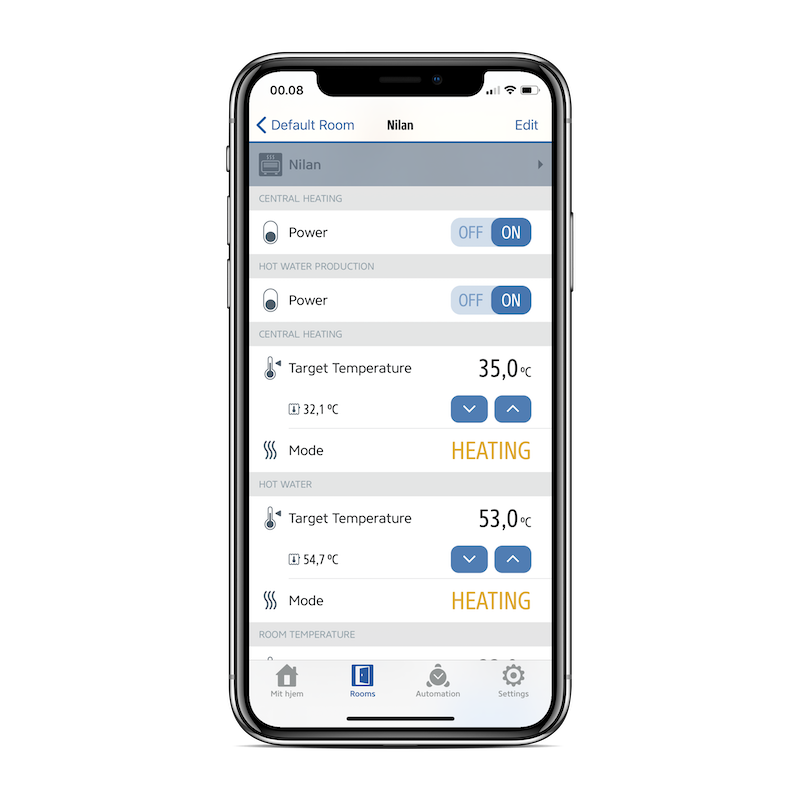Nilan-HK is experimental HomeKit accessory implementation for Nilan (R) CTS700 heatpump. It communicates with Nilan heatpump via Modbus protocol and exposes various readings and settings using Apple HomeKit Accessory Protocol (HAP). Nilan can be accessed and controller from HomeKit-enabled apps, such as Apple Home or Eve.
Software is implemented in Go and is based on hc framework.
Nilan settings in Eve app:
Accessory software is designed for Raspbery Pi computer connected to Nilan heatpump via Ethernet cable. For complete hardware setup, refer to this wiki page.
- Install Go
- Configure environment variables:
HK_PIN: 8 digit PIN code which must be used to authenticate iOS device against accessory. E.g."00102003".NILAN_ADDRESS(optional): Address and port (default 502) of Nilan heatpump. If variable is not provided, accessory software uses factory address of Nilan, which is "192.168.5.107:502".
- Build and run the app with:
go build -o nilan-hk nilan.go
./nilan-hk
- Install Go (minimum version 1.11). For Raspbian, run the following commands:
wget https://storage.googleapis.com/golang/go1.11.8.linux-armv6l.tar.gz
sudo tar -C /usr/local -xzf go1.11.8.linux-armv6l.tar.gz
echo "export PATH=$PATH:/usr/local/go/bin" >> ~/.profile
source ~/.profile
- Clone this repo
git clone pjuzeliunas/nilan-hk
cd pjuzeliunas/nilan-hk
- Install dependencies
go get -u ./...
- Build accessory software:
go build -o nilan-hk nilan.go
- Provide environment variables and run the software:
export HK_PIN=00102003
export NILAN_ADDRESS=192.168.1.20:502
./nilan-hk
HK_PIN: 8 digit PIN code which must be used to authenticate iOS device against accessory.NILAN_ADDRESS(optional): Address and port (default 502) of Nilan heatpump. If variable is not provided, accessory software uses factory address of Nilan, which is "192.168.5.107:502".
If various Nilan readings start being logged, then your software is running as it should. You should now be able to add the accessory to HomeKit-enabled app.
If you want Nilan-HK to be running in background and to start automatically after every reboot, then you have to make it a service. Steps are for Raspbian OS, but you can use them for inspiration on other OS too.
- First of all, build
nilan-hkbinary as described in the previous steps. - Copy
nilan-hkto/usr/bin/ - Create
/etc/systemd/system/nilan-hk.servicetext file with the following content:
[Unit]
Description=Serve Nilan HomeKit via HAP
[Service]
Environment=NILAN_ADDRESS=192.168.1.20:502
Environment=HK_PIN=00102003
ExecStart=/usr/bin/nilan-hk
Restart=on-failure
[Install]
WantedBy=multi-user.target
Remember to adjust environment variables in the file. NILAN_ADDRESS variable is optional.
- Start the service:
sudo systemctl start nilan-hk.service
- Enable the service after every reboot:
sudo systemctl enable nilan-hk.service
-
Room temperature thermostat will always show
OFFstate when it is set toAUTOmode. That doesn't mean that heating/cooling is actually off. It just runs is auto mode. This limitation is twofold:- Apple HAP does not permit having other thermostat (actual) state values than off/heating/cooling.
- In the world of Nilan, "heating" means normal operation without cooling, "cooling" means normal operation without heating and "auto" means just normal operation, in which heating and cooling can be done at the same time. There is no easy way of knowing wether Nilan is heating or cooling at the moment, as it can be doing both in parallel.
-
Switching Central Heating off will simply put it to standby mode (aka pause) for 180 days. After 180 days it will turn on automatically. Swithing it back on will resume normal operation. You can always prolong standby mode by 180 days by turning the switch on and off again.
-
Same logic applies for Hot Water Production switch: off means 180 days pause.
-
Some HAP characteristics of Nilan have non-standard read/write permission attribute, which means that UI in some apps (like Apple Home) might appear distorted. The following services are affected by non-standard access permission attribute on some characteristics:
- Fan:
Active: is read-only.- According to HAP,
Activecharacteristing should be writable. However, Nilan made it pretty difficult to switch the ventilation off in its own CTS700 console (most likely because the ventilation system is designed for running 24/7). With full respect to Nilan design, author made a deliberate choice not to allow switching the ventilation off using HomeKit protocol. - In Apple Home app: switching the Fan off will have no effect.
- Supply Flow thermostat:
TargetHeatingCoolingStateis read-only.- According to HAP,
TargetHeatingCoolingStateof thermostat should permit write operation with one of the 4 possible values: auto, cool, heat or off. Some values are not logical in Nilan supply flow settings, and therefore author decided to disable write access.
- Hot Water thermostat:
TargetHeatingCoolingStateis read-only.- Same reasoning as in supply flow thermostat.
- Fan:
This initial version of software is developed by home automation enthusiast (outside Nilan company) and is based on open Nilan CTS700 Modbus protocol.
Nilan is a registered trademark and belongs to Nilan A/S.
